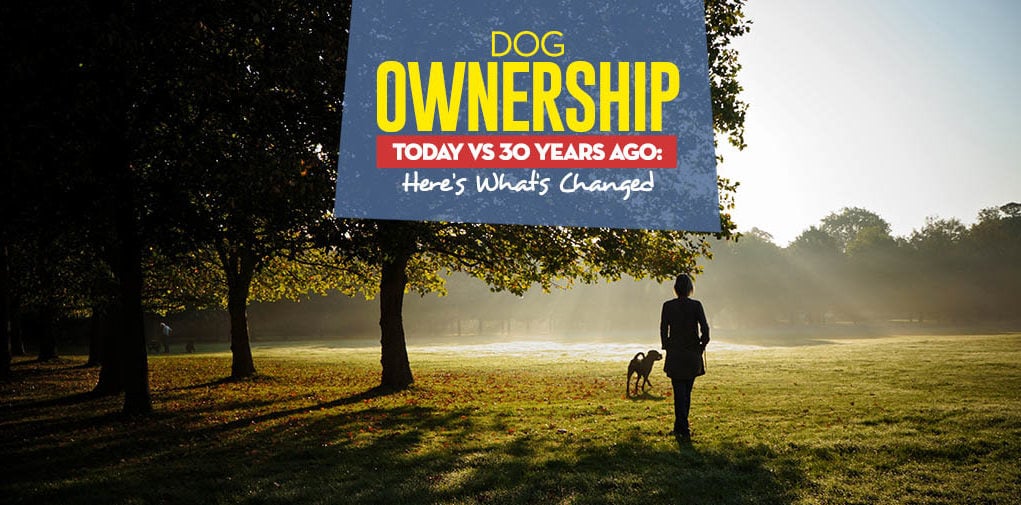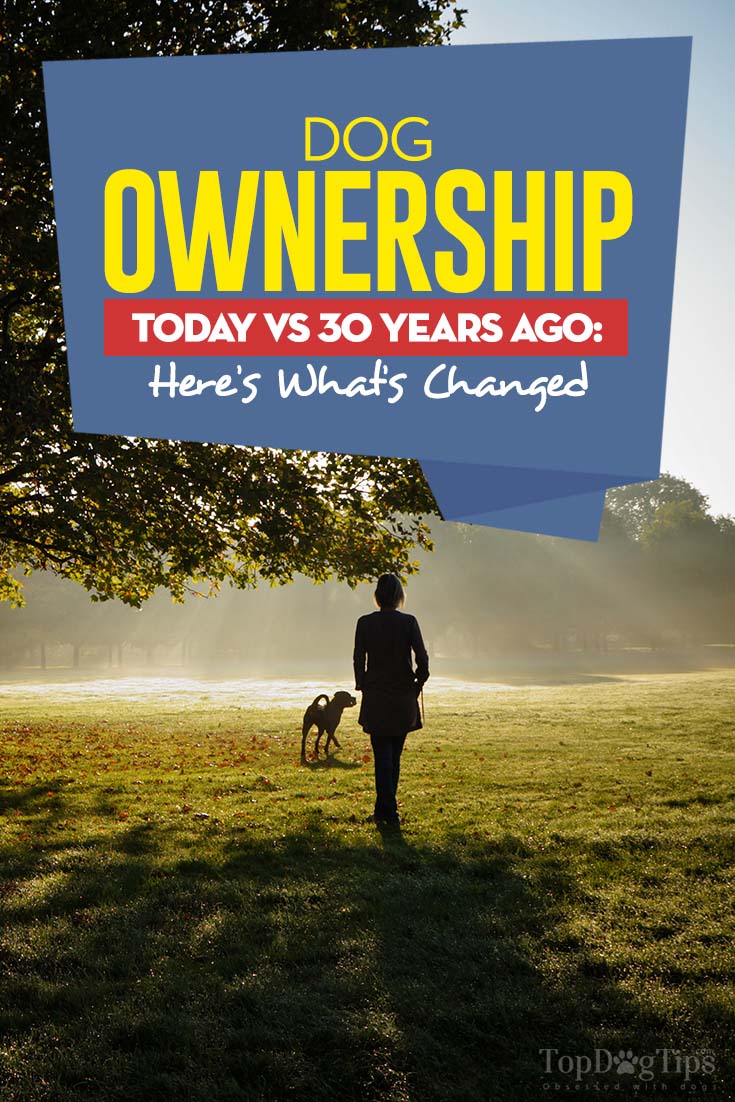If you're here reading this article, then you’re likely from a “dog family” and probably have heard at least one of your parents or grandparents utter the phrase “in my day…” in reference to how you treat a four-legged friend. It’s true, dogs were treated differently a few decades ago, and things have particularly changed a lot in the past 30 years. But what exactly is different in dog ownership today versus 1988?
Dog Ownership and Breed Discrimination
One of the more unfortunate developments in dog ownership over the past 30 years has been the development of breed specific legislation.
It used to be that a household could own a dog of whatever breed they saw fit so long as size requirements were met for rental agreements and the individual dog had no history of aggressive behavior.
Sadly, over the past 30 years, we have seen a merry-go-round of breed discrimination suggestions and laws that target and ban the ownership of specific breeds, with a vast number of dog breeds getting banned in different countries. In the eyes of those less educated in dog ownership, breed specific laws exist to protect against “vicious dogs”. The truth is, however, that these laws do nothing but discriminate against the most popular and trending “vicious breeds”.
It began with the German Shepherd. A dog that was once a major part of war efforts and that supported police forces, began receiving an unfair amount of press when isolated dog attacks took place. This created a mass hysteria that caused landlords everywhere to ban the ownership of this breed. Over time, the hysteria died down and Rottweilers took the brunt of the discrimination.
Years later, the Rottweiler was dethroned by the Pitbull and the breed stayed on this list for quite some time, although the things have been changing and improving for Pitbulls and their owners. Some may remember how Sports Illustrated ran this article in their July 1987 article. Then, twenty years later, the magazine published this piece, which was the complete opposite, painting Pitbulls in a different and more honest light as a dog deserving more sympathy than rage.

Things have been changing, because people – both pet owners and just observers alike – have been educating themselves more on the intricacies of breeding, training and genetics. So, is there any truth to the idea that these dog breeds like German Shepherds and Pitbulls are “vicious” by nature? No, not really (but there's more to that). In general, the idea of saying that all Pitbull dogs are vicious is like saying that all drinkers are alcoholics. It’s simply a broad generalization.
But what is this generalization built on?
If you look at all of the breeds that have discriminated against in the past, you will notice that they are all large and powerful dogs. In the rare incidence that these dogs do bite, they hit the headlines because the damage from that bite is significant. The irony is, however, that smaller dog breeds are much more likely to bite, but because their bite has less power behind it, these stories don’t make the news and they don’t fuel the fire of public disgust.
While today's breed discrimination laws are discouraging, recent efforts by breed advocates indicate a possible shift in the practice – and we have seen plenty of change in that are since the late 1980s – although we aren’t there quite yet.
Feeding Table Scraps
 Many households used to feed their dogs table scraps and leftovers rather than giving them a species-appropriate food (and some still do). This was most often done in households with budgetary constraints, but it was also done due to a lack of awareness of canine dietary needs and feeding table scraps to a dog used to be considered normal.
Many households used to feed their dogs table scraps and leftovers rather than giving them a species-appropriate food (and some still do). This was most often done in households with budgetary constraints, but it was also done due to a lack of awareness of canine dietary needs and feeding table scraps to a dog used to be considered normal.
30 years ago, dog parents were much less educated about their dog’s nutritional needs, because research was much less advanced and because public awareness was simply not a focus for pet food companies. Many things have made the impact on how it's different today. The internet, a rapidly growing number of pet owners, animal cruelty and health awareness among others have made us more aware of the importance of feeding dogs right.
In some poorer countries, commercial dog food wasn't even introduced until 10-20 years ago, therefore many people still continue feeding their dogs a home made diet. In Sri Lanka, for example, feeding dogs a home diet is still normal, mostly due to budgetary constrains and the fact that commercial kibble didn't appear there until the early 1990s. And while in the West a homemade dog food diet is making a comeback, it's in a much better state: pet owners are aware of required nutritional balance, portion sizes and supplements for homemade dog foods that are essential to include.
But how has this shift in feeding our dogs from table scraps to commercial kibble and improved homemade diets influenced the dogs of today? It depends on who you ask. Many members of older generations will tell you that their childhood dog lived to seventeen or eighteen years old and ate nothing but table scraps. Others will tell you that their dogs of today are much healthier than their childhood dog was who was raised on table scraps. But what’s the truth?
Unfortunately, there weren't any studies done 30 years ago on the difference of feeding dogs table scraps compared to commercial kibble. And we're unlikely to see any today either. It’s also hard to isolate a single factor in it’s influence over pet health particularly when modern medicine has come so far, but overall and from an objective point of view from scientists and veterinarians, the pet food of today better meets our dog’s nutritional needs when measured up against table scraps.
Dog Food Selection
Particularly in the U.S., the difference in choices is probably the biggest change we've seen since the late 1980s. Thirty years ago, dog food selection was limited and specialty diets for dogs with unique nutritional needs were few. The dog foods that were available were often lower quality foods that were designed to fit the average household budget, and the price was the primary factor.
 Considering the limited selection of dog food that used to be available, the selection of dog foods available today borders on the absurd. We’ve gone from foods designed for broad life stages to foods for unique health demands, foods that fit fad diets, and foods that cater to picky pet owners. We now even have to filter out through thousands of diets, recipes and formulas just to pick out top dog foods that are actually worth the price tag.
Considering the limited selection of dog food that used to be available, the selection of dog foods available today borders on the absurd. We’ve gone from foods designed for broad life stages to foods for unique health demands, foods that fit fad diets, and foods that cater to picky pet owners. We now even have to filter out through thousands of diets, recipes and formulas just to pick out top dog foods that are actually worth the price tag.
But is this abundance a good thing?
For dogs that have allergies, intolerances, or unique health conditions, the changes in the dog food industry are welcomed. A number of limited ingredient and hypoallergenic dog food recipes have been designed by scientists and veterinarians on the company's payroll to address the needs of ailing dogs. These new pet foods offer better nutrition to dogs that would previously have suffered from malnutrition or unpleasant side effects from more basic “one-fit-for-all” foods.
For dogs without these health issues, however, feeding a more limited diet can lead to the development of these issues in the future which is obviously not a good thing. For example, think of a dog that eats chicken and rice for most of their life. When this dog grows older, their parent decides to start feeding more diverse foods. The problem is that their dog’s digestive system that has been used to a gentle diet is now being taxed with new and more complex nutrients.
So, what’s the answer? It’s simple really. If your Fido has unique dietary needs, meet them with specialty foods. If your dog has no unique dietary needs, vary their diet to include a range of ingredients for diverse nutrition. Veterinarians warn that pet owners should avoid jumping onto fad diets like grain-free feeding (which recently hit the news after FDA saw a link between these diets and heart disease in dogs) when there's absolutely no reason for a healthy dog to switch to that diet.
Advancements in Veterinary Care
 As with human medicine, veterinary medicine has grown by leaps and bounds over the past 30 years. Pet owners are being given more and more options for treatment of illnesses that would once have sentenced their pet to euthanasia. Veterinarians are much better educated today because of massive advancements in the science of canine nutrition and health. This trickles down to pet owners who can manage to take better care of their dogs.
As with human medicine, veterinary medicine has grown by leaps and bounds over the past 30 years. Pet owners are being given more and more options for treatment of illnesses that would once have sentenced their pet to euthanasia. Veterinarians are much better educated today because of massive advancements in the science of canine nutrition and health. This trickles down to pet owners who can manage to take better care of their dogs.
What would pet owners thirty years ago say if you told them that they have to brush their dogs' teeth on a daily basis?
Of course, all this progress and advancement in understanding dog care and health is a blessing, but it also means that pet ownership has become much more expensive.
Dogs today receive monthly preventatives, they have annual checkups with a plethora of vaccinations to prevent other preventable diseases, and they are prescribed medicines to better manage symptoms that would have previously crippled them. In today’s society, these things are certainly not optional, and they have increased the cost of pet ownership exponentially. That said, few pet owners would argue the fact that these advancements are worth the added expense.
Pet Insurance
Speaking of veterinary care and the rising cost of pet ownership, another change that has taken place over the past 30 years is the prevalence of pet insurance policies. The pet insurance market has been growing in large numbers over the last few decades, and particularly since 2007 up to 2017. But this is mostly a very recent trend (that's unlikely to change).
There was a time when the thought of getting health insurance for your dog was absurd. Our dogs were looked upon as possessions and although veterinary care was a given, any forethought for large veterinary expenses was quite simply not there. As the years have progressed, however, we have begun to see our dogs as family members and we plan for emergency health care for them as we would for our other family members.
There is no doubt that veterinary insurance plans still have a way to go before they would be considered ideal, but they do offer some degree of financial relief to pet parents and afford the opportunity to consider more expensive veterinary procedures that may otherwise have been off the table. As long as pet owners know how to pick the right pet insurance plan for their specific dog, it can be a huge win in savings.
Improved Animal Advocacy
Thirty years ago, there was much less awareness of the concept of puppy mills and backyard breeders. People who wanted a dog simply went out and got one with much less regard for where that dog came from, or how their decision can impact the state of dog population, than there is today.
 Today we know better. Much better, because the internet will not allow us to forget. We are aware of the conditions in which dogs are kept on puppy farms and in backyard breeding operations. We are also aware that dogs that are born into this type of environment are more often than not sickly dogs, poor examples of their breed, and expensive dogs to raise due to their increasing health demands. Studies have shown that over and over.
Today we know better. Much better, because the internet will not allow us to forget. We are aware of the conditions in which dogs are kept on puppy farms and in backyard breeding operations. We are also aware that dogs that are born into this type of environment are more often than not sickly dogs, poor examples of their breed, and expensive dogs to raise due to their increasing health demands. Studies have shown that over and over.
Through our increased awareness of what these types of breeding operations are doing to dilute the gene pool as well as the incredibly cruel treatment that these dogs endure, we have developed regulatory groups and increased public awareness to bring an end to these types of operations. Many states are now completely banning puppy mills, with California leading the way in promoting adoption of dogs and regulated legitimate breeders.
Although it’s a slow-moving process, we have already seen the effects these bans on pet stores selling puppy mill dogs are doing. Additionally, we have seen harsher regulations on where puppies can be sold locally and tougher punishment for those who continue to run this type of breeding operation. We aren’t there yet, but hopefully, in the next few years, these abhorrent breeding operations will be eradicated completely as more pet owners become aware of reputable breeders and know how to distinguish and report puppy mills to the authorities.
Dogs with Therapeutic Roles
 I've already mentioned the shift of dogs from being possessions of humans to being a part of our family. Even though this shift has started a long time ago – like hundreds of years ago – the actual role of dogs in our lives has developed even further over very recent years. So much so that even the most pet loving humans are still puzzled how did dogs get to this point (and not that we're complaining – it's a great thing and huge progress).
I've already mentioned the shift of dogs from being possessions of humans to being a part of our family. Even though this shift has started a long time ago – like hundreds of years ago – the actual role of dogs in our lives has developed even further over very recent years. So much so that even the most pet loving humans are still puzzled how did dogs get to this point (and not that we're complaining – it's a great thing and huge progress).
Dogs have long played a role in professional careers and as service animals for those with disabilities, but in the last decade or so, pets have been taking on roles more therapeutic roles as emotional support animals for their owners, among other jobs. And there are funds delegated for scientists to research this area further, who continue to find evidence and present cases of how these support animals help people in their daily lives.
But what exactly is an emotional support dog? It’s an animal that provides psychological support for their owner. These dogs differ from service dogs because they are not professionally trained, and they do not perform specific tasks for their owners the way that a seeing eye dog might. Emotional support dogs are also not afforded the same protection under the law as service animals are, but they do allow for some benefits such as housing in a complex where pets would otherwise be forbidden.
Is this increased reliance on our dogs for support a good thing?
It can certainly be beneficial, but unfortunately, due to the nature of some people, the use of pets as emotional support dogs has presented a wealth of problems. Most notably, pet owners abusing the label of “support animal” for their pets to be afforded privileges that they would otherwise not receive. This abuse leaves a bad taste in the mouth of others and consequently blackens the reputation of genuine service animals, which also hurts people who really depend on their ESAs.
It appears now that over the past thirty years, we have taken the inclusion of our dogs from one extreme to another. Although in consideration of the two sides of the spectrum, we are certainly at the more preferred extreme which we hopefully can continue to polish.
Outside/Inside Dogs
This is likely one of the first aspects anyone would think about and remember when discussing the differences of dog care and ownership of today versus thirty years ago. Unlike the over-labeling of our dogs as emotional support animals, there is no drawback to our increasing abandonment of the idea of “outside dogs” or “outdoor dogs”. Many countries now look at this the same way as not providing shelter to your children, and such owners are at risk of being punished for animal cruelty.
 Thirty years ago, it used to be that many (if not most) dogs were kept outside of the home and there was little repercussion for failing to bring dogs inside to be part of the family. It was normal for many owners. Over the past decades, fortunately, increased awareness of the drawbacks of keeping dogs isolated from the family has led to fewer dogs being kept as “outside only dogs”.
Thirty years ago, it used to be that many (if not most) dogs were kept outside of the home and there was little repercussion for failing to bring dogs inside to be part of the family. It was normal for many owners. Over the past decades, fortunately, increased awareness of the drawbacks of keeping dogs isolated from the family has led to fewer dogs being kept as “outside only dogs”.
This shift is not just beneficial for the overall health of our dogs, but it has also led to stronger bonds between dogs and their families. Keeping dogs inside means treating them as part of the family, which results in many other benefits for the dogs and their owners, like any of those mentioned above.
Change is Good, Let's Keep It Up
There is no doubt that things are different for pet owners (and their dogs) these days, but for the most part, these changes are good. They allow us to properly protect our pets against disease and provide them with the proper nutrition needed for a healthy lifespan. We've raised awareness of animal cruelty and managed to include pets as real part of our families, which benefits not only the dogs but the owners, too.
READ NEXT: 25 Benefits of Kids Growing Up with Pets [Infographic]




